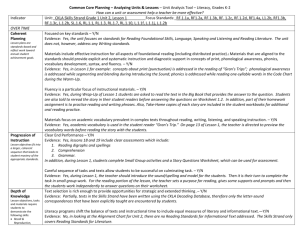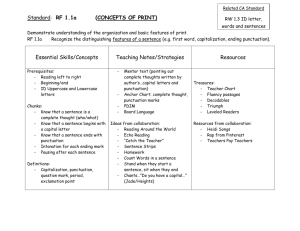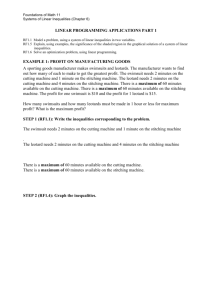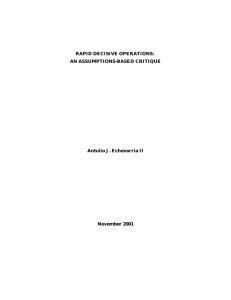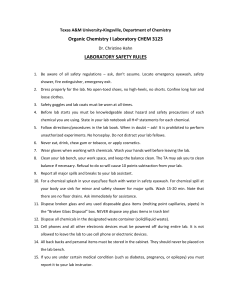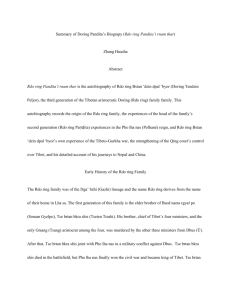Abstract
advertisement
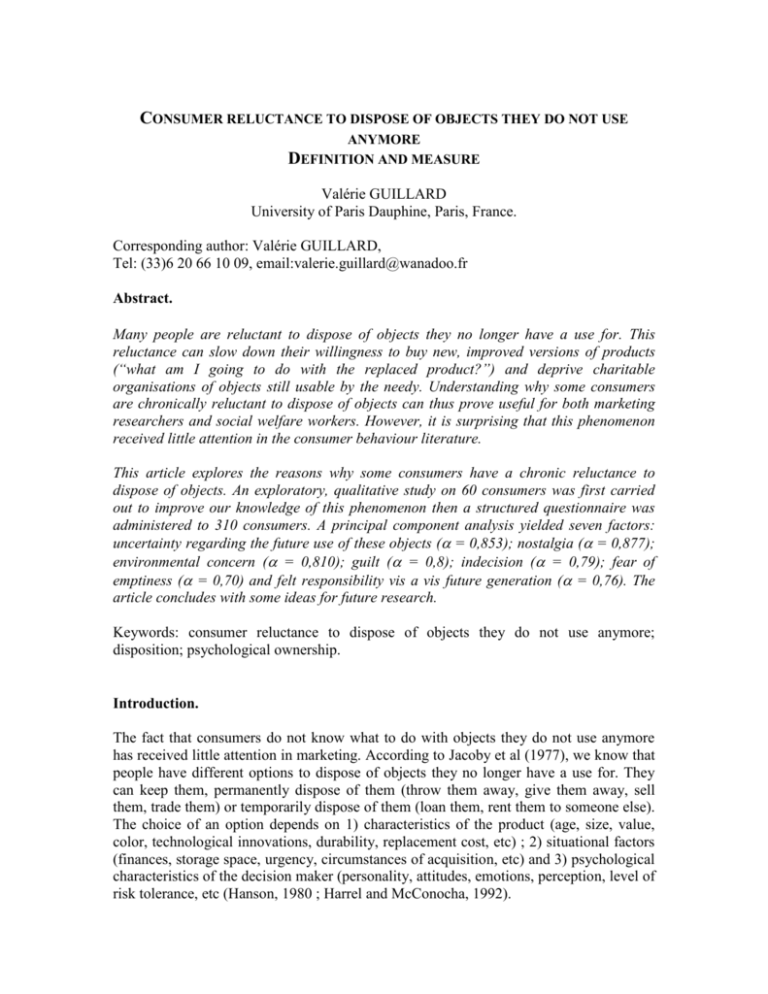
CONSUMER RELUCTANCE TO DISPOSE OF OBJECTS THEY DO NOT USE ANYMORE DEFINITION AND MEASURE Valérie GUILLARD University of Paris Dauphine, Paris, France. Corresponding author: Valérie GUILLARD, Tel: (33)6 20 66 10 09, email:valerie.guillard@wanadoo.fr Abstract. Many people are reluctant to dispose of objects they no longer have a use for. This reluctance can slow down their willingness to buy new, improved versions of products (“what am I going to do with the replaced product?”) and deprive charitable organisations of objects still usable by the needy. Understanding why some consumers are chronically reluctant to dispose of objects can thus prove useful for both marketing researchers and social welfare workers. However, it is surprising that this phenomenon received little attention in the consumer behaviour literature. This article explores the reasons why some consumers have a chronic reluctance to dispose of objects. An exploratory, qualitative study on 60 consumers was first carried out to improve our knowledge of this phenomenon then a structured questionnaire was administered to 310 consumers. A principal component analysis yielded seven factors: uncertainty regarding the future use of these objects ( = 0,853); nostalgia ( = 0,877); environmental concern ( = 0,810); guilt ( = 0,8); indecision ( = 0,79); fear of emptiness ( = 0,70) and felt responsibility vis a vis future generation ( = 0,76). The article concludes with some ideas for future research. Keywords: consumer reluctance to dispose of objects they do not use anymore; disposition; psychological ownership. Introduction. The fact that consumers do not know what to do with objects they do not use anymore has received little attention in marketing. According to Jacoby et al (1977), we know that people have different options to dispose of objects they no longer have a use for. They can keep them, permanently dispose of them (throw them away, give them away, sell them, trade them) or temporarily dispose of them (loan them, rent them to someone else). The choice of an option depends on 1) characteristics of the product (age, size, value, color, technological innovations, durability, replacement cost, etc) ; 2) situational factors (finances, storage space, urgency, circumstances of acquisition, etc) and 3) psychological characteristics of the decision maker (personality, attitudes, emotions, perception, level of risk tolerance, etc (Hanson, 1980 ; Harrel and McConocha, 1992). The impact of these variables has never been empirically generalized. Moreover, these researches have studied disposition in general, without focusing on individual differences. While some consumers have no difficulty to get rid of these objects, others are very reluctant to do so. Why? While under-studied, this field is extremely interesting for the associations that have to choose the means of collecting objects. Indeed, even if people have a propensity to keep their belongings, one day or another, they may face the problem to get rid of them. How do they deal with it? The objective of this research is to know their psychological blockages. It aims at understanding the reasons why some people are reluctant to dispose of objects 1) that they do not have any use for them anymore, 2) that are not worth being sold and 3) that are still usable by others. Theory on compulsive hoarding suggests that avoiding decisions about discarding possessions may stem from a fear of mistakes. According to them, the decision making deficit results from a higher threshold for deciding what to discard. When people decide to discard a possession, they make a judgment that we will not have a need for it in the future. Compulsive hoarders mistakenly judge the likelihood of future need as higher than do nonhoarders. Moreover, the perceived consequences of not having a possession when it is needed are more damaging for hoarders (Frost et al, 1995). Theory on psychological ownership suggests the presence of individual differences in the relationships between objects and individuals (Belk, 1988; Pierce et al, 2003). According to studies in the field, a strong relationship exists between an individual and an object in which the object is experienced as having a close connexion with the self. Feeling of ownership fulfils basic needs: 1) efficacy, objects enable people to have the pleasure to control one’s environment (Furby, 1978); 2) self identity, objects help people define themselves, express their self identity to others and maintaining the continuity of self identity (Belk, 1988; 1990) and 3) having a place to dwell, objects provide the individual both physical and psychic security (Porteous, 1976). These motives explain why people keep objects they do not use anymore. To dispose such objects, people have to leave emotional and psychological lies with their objects. To urge this process of detachment from the self (Young and Wallendorf, 1989), people have some rituals. They store them without use or clear intent toward future use. Possessions migrate from the house to attics or cellar. This distance enables people to assure safe passage. This passage reassures them because they kept them close if they have a desire or need for them. The importance a consumer attaches to worldly possessions is called materialism. According to Belk (1984), materialism is composed of three dimensions: envy, nongenerosity and possessiveness. Possessiveness is “the inclination and tendency to retain control or ownership of one’s possession” (Belk, 1983). The conceptual domain of possessiveness includes a concern about loss of possession. Moreover, having favourable affect toward things from the past is the definition of nostalgia (Holbrook, Schindler, 1991). Objects are stimuli which enable nostalgic people to relive events. Getting rid of such objects prevent us to come back in their idealized past. The tendency to avoid making and/or postponing decisions may be a result of a fear of making mistakes (Frost and al, 1995). Saving objects may be a way of avoiding decision-making. It concerns people who have a tendency to procrastinate. Harrell and al (1992) obtained a negative relationship between the tendency to keep and age. Young people are probably less concerned with problems of accumulating objects. Moreover they show that women are less likely to keep than men. Taken together, those studies emphasise the need to better understand disposition and individual differences in the decision of disposition. This individual difference construct will be conceptualised as a personality trait and will be called Reluctance to Dispose Objects people no longer have a use for (RDO). We define RDO as a general and relatively stable consumer disposition to manifest reluctance to give them or to throw them away. A measurement scale of RDO was developed to test its link with the personality variables evoked above. 2. Method. 2.1. Exploratory research An exploratory study was conducted among 60 students in order to 1/ know the percentage of consumers who are reluctant to dispose of objects and 2/ generate items in order to build the measurement scale. The scenario they were confronted with is presented below: “You replace a laptop [books, clothes, shoes, several items were proposed]. What do you do of the former one?” Eighty percent (50 out of 60) declared they kept objects. We also concluded that it is a behaviour which concerns a lot of people. So, we developed a measure to identify and understand this behaviour. 2.2. The RDO development scale. Fifty items were administered to construct a scale (due to space limitations, the items selection procedure is not presented here). CFA were run (N = 180; mean age : 22 years ; KMO index>0,5 and significant Bartlett test). Seven subscales were developed. Among these subscales, there were five measures personality traits or feelings towards objects Guilt ( = 0,8), “I will feel guilty if I dispose of it ”, « I feel I do a fault if I do not keep it », “I keep it because I offend someone if I throw it away”, “I feel some remorse for getting rid of objects” ; Indecision ( = 0,79) “I never know if I have to dispose of it or not”, « I can not make the decision to get rid of objects », « It is always the fear of making mistakes which prevents me to dispose them»; Environmental concern ( = 0,810) “ To built them, we need materials and it causes damage in environment” ; « I keep them until that I find an industry to recycle them » ; « I feel guilty when I threat environnement”, Fear of emptiness ( = 0,70) “ I abhor a vacuum” “ I feel anxious if I part with my objects”; Felt responsibility vis a vis future generation ( = 0,76) “ I keep them [books] because I will show them to my children” ; “ I would like to pass on future generation”. Indeed, the RDO scale was developed to measure the general consumer reluctance to dispose of objects people no longer have a use for. So, we decide that only items measuring relationships with objects enable to capture this phenomenon. One item was removed because it does not enable to categorize people who have RDO “I do not have time to get rid of objects”. Another CFA was run (N = 330). At this stage of development the RDO scale consists of seven items. The response format was a Likert scale going from “never” to “very often”. 2.2. The Richins materialism scale Materialism was measured by using Richins’s scale. They conceptualize materialism as a consumer value. According to Richins and Dawson (1992), three components measure materialism: acquisition centrality; the role of acquisition in the pursuit of happiness and the role of possessions in defining success. This scale consists of 18 items measured by 5 points numerical scale of agreement/disagreement. The scale was used in a French context. It has good psychometric qualities (Delacroix, 2003). 2.3. The Holbrook nostalgia index Holbrook (1991) has developed a Nostalgia Index. It assesses individual differences in the tendency to feel nostalgia impulses. This index consists of 20 statements related to the general theme that “things were better in the good old days”. Each statement is measured by a 9 point numerical scale of agreement/disagreement. Half of the items are scored in the positive, half in the negative direction. 2.4. The Tuckman Procrastination scale The Tuckman Procrastination scale is a 16 item measure of the tendency to overly delay starting and finishing tasks and duties “When I have a deadline, I wait till the last minute”. This scale has a 4 point answer scale of agreement/disagreement. 2.5. Procedure and subjects A total of 330 subjects, 100 adults and 230 students were approached in this study. Their profile was as follow: adult sample (mean age = 41 years, male = 30%; female = 70) and student sample (male = 43%; female = 57%; mean age = 21 years). All subjects were asked to participate on a voluntary basis and anonymity was guaranteed. The students were tested after a class. The adult were tested in an airport. It took them approximately 15 to 20 minutes to complete the questionnaire. 3. Results. 3.1. Factor analysis of the RDO scale. The correlation matrix of the seven items was factor analyzed using Principal Components method. The criterion for factor extraction was an eigen value equal or greater than 1. Two factors explained 67 % of variance. The two factors are independent (r = 0,042). Moreover a maximum likelihood confirmatory factor analysis on these six items indicated that two factors model fit the data well (AGFI = 0,923; SRMR = 0,10; RMSEA = 0,06 ; Chi2/ddl = 2,50). Table 1 – Factor loadings for the RDO scale. Dimensions Sentimental They belong to my past and I don’t want to forget them ! I save them, they remind me of something I may take pleasure in rediscovering them later ! I save them, they enable me to remember who I was ! They may still come in useful We are never careful enough! I could need them later. May be, I would like to use them again one day. Instrumental ,832 ,826 ,800 ,773 ,864 ,802 ,741 Table 2 – Reliability scores for the RDO scale. Sentimental RDO Instrumental RDO N Mean 2,98 Cronbach alpha 0,824 Joreskog coefficient 0,811 330 330 4,36 0,749 0,790 3.2. Correlations with other personality scales. The validity of RDO scale was assessed by determining its relationships with theoretically related personality scales. The results are summarized in table 3. They indicate that the RDO scale is related to nostalgia (r = 0,323, p<0,01). However, the relations between RDO and materialism and between RDO and procrastination were not significant. Table 3 – Correlations between personality measures and RDO. Personality scale Nostalgia Coefficient alpha Sample size 0,70 180 Correlation with the RDO scale Sentimental Instrumental RDO RDO 0,323 ** 0,135 Materialism Procrastination 0,69 0,80 180 180 0,022 0,034 -0,003 -0,019 3.3. Relationships to demographics The relationships between RDO scale and gender and RDO scale and age was explored using an univariate analysis of variance (ANOVA). There was no significant difference between men and women (F = 1,682 = 0,125). However, the mean of women seemed to be higher than the mean of men. To test the mean between RDO scale and age, we divided our sample in two parts: one above 25 years and one below this age. There was no significant difference between the two groups (F = 0,389 ; P = 0,583). 3.4. Effect of RDO on the tendency to keep, to give and throw objects they do not use anymore. To explore the nomological validity of the RDO instrument, we tested the links between RDO and three options available to people when they contemplate the disposition of a product: to keep, to give and to throw them away. Correlations are shown in table 4. The dependant variable (three options) was measured thanks to one item by 7 points numerical scale of never/very often. At the end of the questionnaire, we ask people “What do you do of these objects”. This is especially people with instrumental RDO who keep objects and who do not give them. Table 4 – Correlations between RDO and tendency to keep, give and throw objects people do not use anymore. Dependant variable (behaviour) I have tendency to keep objects I have tendency to give objects I have tendency to throw them Correlation with the RDO scale Sentimental Instrumental RDO RDO 0,331** 0,581** -0,032 -0,212** -0,236** -0,222** 4. Discussion. This work aims at explaining why people have reluctance to dispose of objects they do not use anymore. After an exploratory research, a scale was developed to identify this phenomenon. This work has shown that the RDO scale has reasonable construct validity. Two dimensions explain why people have reluctance to get rid of objects they do not use anymore. Instrumental dimension refers to judgments about the future use or need for a possession. Sentimental dimension refers to the emotional attachment associated with possession. RDO was found to be related to nostalgia as expected by theory. However, there was no significant link between materialism and RDO. This result may be surprising since Belk (1988) define this personality trait like an attachment with worldly possessions. But, according to this author (1988), materialism is a way to seek psychological well being via consumption. Although one of the dimension measures loss of possession (possessiveness subscale), only one item refers to the tendency to dispose of objects “I tend to hang on to things I should probably throw out”. Materialism’s scale does not explain why people are reluctant to get rid of objects they do not use anymore. Another study should verify if there is a link with Belk’s scale and RDO’s scale. Moreover, there was no significant link between procrastination and RDO. People make the decision to keep objects they do not use anymore. Further research needs to be run to validate not only another personality trait but also to explore the link between RDO and demographic variables such as age and gender. The relationships between RDO and gender and RDO and age are not significant. Further research needs also to be run with a sample only composed of adult. Another aim of this research was to explore the link between RDO and three behaviours: the tendency to give, to keep and to throw objects away. There was significant correlation between instrumental RDO and the three behaviours. This result is consistent with our hypothesis that RDO leads people to keep objects and do not get rid of them. On the other hand, sentimental RDO was only correlated with the tendency to keep and to throw away. It is consistent with literature. Several studies revealed how people dispose of meaningful possessions. According to their findings, some consumers want to exercise control over the future life of their possessions when they decided to dispose of them. They give them only when they know the future beneficiary (Lastovicka and Fernandez, 2005; Price et al, 2000). But these researches do not explore who are these consumers. Do they have RDO? Further research needs to be run to explore these links. References Belk R.W. (1988), Possessions and the Extended Self, Journal of Consumer Research, 15 (September), 139-168. Belk R.W. (1989), Extended Self and Extending Paradigmatic Perspective, Journal of Consumer Research, 16 (June), 129-132. Belk R.W. (1990), The Role of Possessions in Constructing and Maintaining A sense of Past, Advances in Consumer Research, 17, 669-676. Darpy D. (1988), La procrastination du consommateur: proposition d’une échelle de mesure, Thèse de doctorat en sciences de gestion, Université Paris IX Dauphine, Paris. Delacroix E. (2003), La tendance à regretter du consommateur, Thèse de doctorat en sciences de gestion, Université Paris IX Dauphine, Paris. Hanson J.W. (1980), A proposed paradigm for consumer product disposition processes, The Journal of Consumer Affairs, 14(1), 49-67. Harrell G.D. et McConocha D.M. (1992), Personal Factors Related to Consumer Product Disposal Tendencies, The journal of Consumer Affairs, 26(2), 397-417. Holbrook M.B., Schindler R.M. (1991), Echoes of the Dear Departed Past: Some Work in Progress On Nostalgia, Advances in Consumer Research, 18, 330-333. Jacoby J., Berning C.K. et Dietvorst T.F. (1977), What about disposition?, Journal of marketing, april, 22-28. Lastovicka et Fernandez (2005), Three Paths to Disposition: The Movement of Meaningful Possessions to Strangers, Journal of Consumer Research, 31, 813-823. Pierce J.L., Kostova T., Dirks K.T. (2003), The State of Pscyhological Ownership: Integrating and Extending a century of Research, Review of General Psychology, 7(1), 84-107. Price L.L, Arnould E.J., Curasi C.F. (2000), Older Consumers’ Disposition of Special Possession, Journal of Consumer Research, 27, 179-201. Richins M.L. (1994), Valuing Things: The Public and Private Meanings of Possessions, Journal of Consumer Research, 21, 504-521. Roster C.A. (2001), Letting Go: The Process and Meaning of Dispossession in the Lives of Consumers, Advances in Consumer Research, 28, 425-430.
